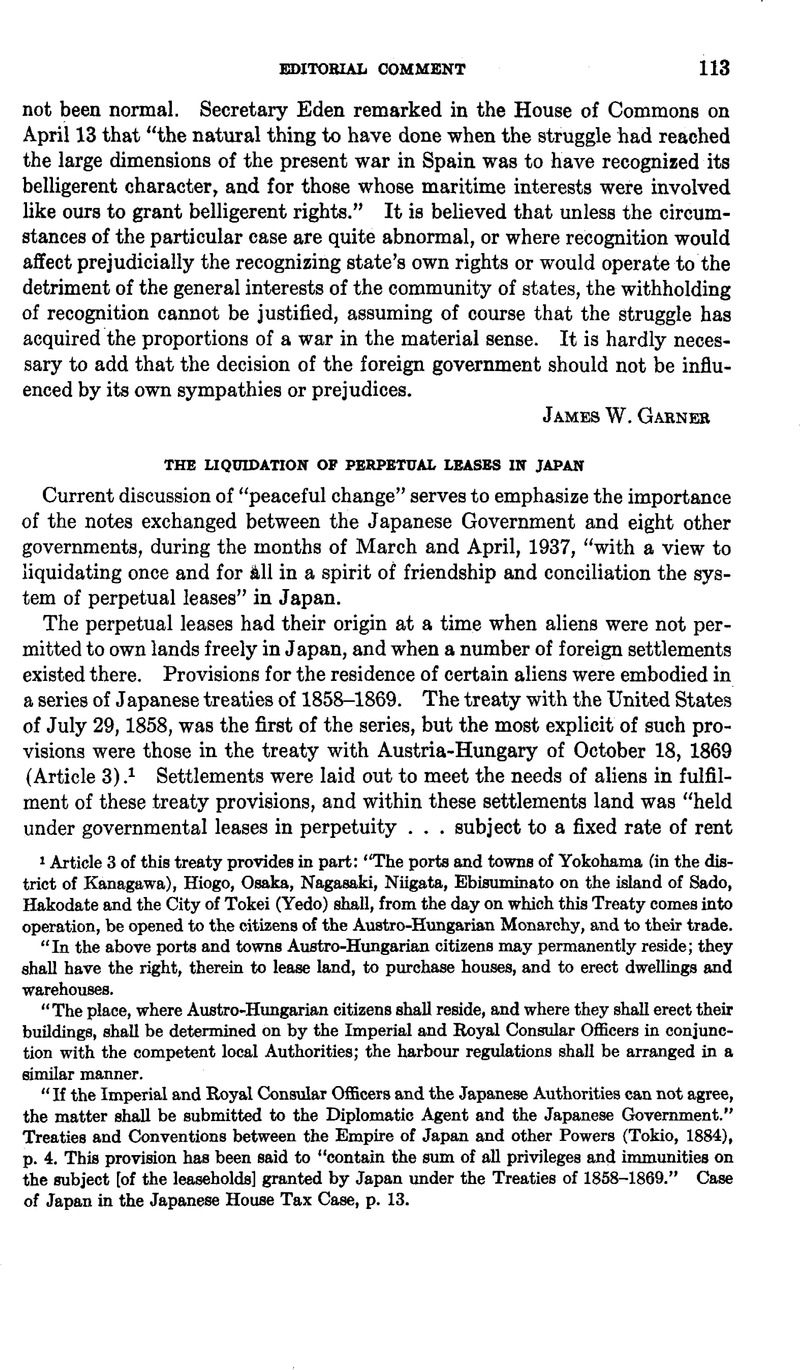Published online by Cambridge University Press: 12 April 2017

1 Article 3 of this treaty provides in part: “The ports and towns of Yokohama fin the district of Kanagawa), Hiogo, Osaka, Nagasaki, Niigata, Ebisuminato on the island of Sado, Hakodate and the City of Tokei (Yedo) shall, from the day on which this Treaty comes into operation, be opened to the citizens of the Austro-Hungarian Monarchy, and to their trade.
“In the above ports and towns Austro-Hungarian citizens may permanently reside; they shall have the right, therein to lease land, to purchase houses, and to erect dwellings and warehouses.
“The place, where Austro-Hungarian citizens shall reside, and where they shall erect their buildings, shall be determined on by the Imperial and Royal Consular Officers in conjunction with the competent local Authorities; the harbour regulations shall be arranged in a similar manner.
“If the Imperial and Royal Consular Officers and the Japanese Authorities can not agree, the matter shall be submitted to the Diplomatic Agent and the Japanese Government.” Treaties and Conventions between the Empire of Japan and other Powers (Tokio, 1884), p. 4. This provision has been said to “contain the sum of all privileges and immunities on the subject [of the leaseholds] granted by Japan under the Treaties of 1858–1869.” Case of Japan in the Japanese House Tax Case, p. 13.
2 Case of Japan in the Japanese House Tax Case, pp. 15–16. The tsubo is the equivalent of 3.305785 square meters, id., p. 17; an acre is about 1225 tsubo.
3 Id., p. 67. See, also, Reischauer, , “Alien Land Tenure in Japan,” in Transactions of the Asiatic Society of Japan, 2d series, Vol. XIII.Google Scholar
4 On March 25, 1937, a Japanese “Foreign Office Spokesman” was reported to have said that “out of a total of 146,000 tsubo of land (about 119 acres) held under perpetual lease, 64,000 isubo (about 52 acres) represents the land held by British and 32,000 tsubo (about 26 acres) by American nationals.” 6 Contemporary Japan (June, 1937), p. 170. See also 16 Department of State Press Releases (March 6,1937), p. 134; 6 Far Eastern Survey (May 12, 1937), p. 107.
5 86 British and Foreign State Papers, p. 46. See also Arts. 1 and 3 of the same treaty.
6 These treaties are collected in Treaties and Conventions between the Empire of Japan and Other Powers (Tokio, 1899).
7 Scott, , Hague Court Reports, p. 77.Google Scholar
8 Recueil des Traités et Conventions entre le Japon et les Puissances Etrangéres (1925), I, p. 745.
9 Reischauer, , op. cit., pp. 123–130; Yamada, in McKenzie's Legal Status of Aliens in Pacific Countries (1937), p. 211.Google Scholar
10 U. S. Executive Agreement Series, No. 104; British Treaty Series, No. 29 (1937).
11 Elaborating this expression, a second exchange of notes between the United States and Japan, also of March 25, 1937, provided that “until March 31, 1942, no taxes at present in force shall be collected other than those heretofore collected from the leaseholders, nor shall any taxes which may be introduced in the future be collected from the leaseholders if such taxes are directly connected with the perpetual leaseholds.” It was also stipulated that “in the event of an American leasehold being transferred it … shall continue to be subject to the terms of the understanding” reached. U. S. Executive Agreement Series, No. 104.
12 36 (Japanese) Journal of International Law and Diplomacy, No. 6 (July, 1937).
13 16 Department of State Press Releases (March 6, 1937), p. 134.